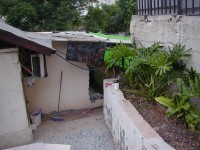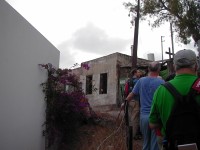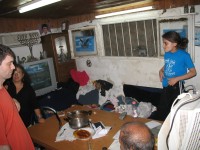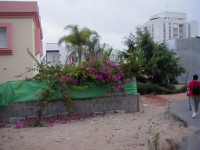Page 2: Our Trip - Kfar Shalem
But let's start talking about our trip with one of our
"listening" stops, and point out - as Eunice convinced me - that
talking
about problems (as opposed to just "common values") can be
helpful. One of the places we visited in Israel was located in
the slums of Tel Aviv. We were there at twilight and it was hard
to photograph, but we have a few.



How did this particular slum, Kfar Shalem, come about? Well, it
was a Palestinian community, in Jaffa - that's the Palestinian city of
which Tel Aviv was once a little Jewish suburb, in 1948. The residents
fled, or were expelled, in the 1948 war. Everyone, I think, hoped
they'd be back in a few days or a few weeks, but it didn't
happen. And then a bunch of Jewish refugees arrived from Yemen
and some other Muslim countries, and they needed housing. The
Israeli government put them in these vacant houses, saying it was
"temporary." And they are still there, close to 60 years
later.
 These people feel very discriminated against. European refugees
were settled in agricultural villages, the kibbutzim and moshavim, and
got title to the land they were on. When the suburbs reached that land,
many of them sold it at high prices. The so-called Mizrachi, or
Eastern Jews, who were settled in these poor Palestinian houses, never
got title to them. The government has always treated them as
temporary tenants. Because they never had title, they could never
get home improvement loans and could not get building permits to fix up
the places. So they are now slums, surrounded by modern high-rise
expensive apartment buildings.
These people feel very discriminated against. European refugees
were settled in agricultural villages, the kibbutzim and moshavim, and
got title to the land they were on. When the suburbs reached that land,
many of them sold it at high prices. The so-called Mizrachi, or
Eastern Jews, who were settled in these poor Palestinian houses, never
got title to them. The government has always treated them as
temporary tenants. Because they never had title, they could never
get home improvement loans and could not get building permits to fix up
the places. So they are now slums, surrounded by modern high-rise
expensive apartment buildings.
They need urban renewal - slum clearance. But
you know how controversial that was in the US - there were times when
the residents of slums got booted out with no place to go. The slang
was "Negro Removal." In Israel one might say, "Yemenite
Removal."
This is not a group of anti-Israelis.
They are patriotic Israelis, many are army careerists as the army is
regarded as more welcoming to Mizrachis than many other institutions in
Israeli society. And they are active and practicing Jews - the
neighborhood is dense with synagogues that are still organized along
the lines of the places they came from when they came to Israel.
(More pictures available...)
Well, our group visited there. We got
information from the locals about what was going on. And as we
talked to other groups, members of our group told them about it.
Some of the other groups knew more about lawyers, courts, how to
agitate at the Knesset (the parliament). These included Rabbis
for Human Rights and The Israeli Committee Against House Demolitions.
And so as a result of a group of Americans visiting and talking about
the problem, it got on the political map. The evictions have been
postponed and there are some negotiations going on. I understand the
government is now (Sept 2007) offering about $60,000 to each family
group being
evicted. That doesn't really solve the problem, because the
people want to stay together in a community, near their jobs, near
their synagogues, and I
doubt that $60,000 is enough even for a down payment in the
neighborhood once it is modernized - but at least the problem is now on
the map and being
argued.
>NEXT PAGE
Ordman Net Home
Israel/Palestine Info Home
CONTENTS:
Page 1: Introduction
Page 2: Kfar Shalem
Next > Page 3: Duheisha Refugee Camp
Page 4: Universities
Page 5: The Wall / Security Barrier
Page 6: Bethlehem
Page 7: Efrat
Page 8: Hebron
(More to come)



 These people feel very discriminated against. European refugees
were settled in agricultural villages, the kibbutzim and moshavim, and
got title to the land they were on. When the suburbs reached that land,
many of them sold it at high prices. The so-called Mizrachi, or
Eastern Jews, who were settled in these poor Palestinian houses, never
got title to them. The government has always treated them as
temporary tenants. Because they never had title, they could never
get home improvement loans and could not get building permits to fix up
the places. So they are now slums, surrounded by modern high-rise
expensive apartment buildings.
These people feel very discriminated against. European refugees
were settled in agricultural villages, the kibbutzim and moshavim, and
got title to the land they were on. When the suburbs reached that land,
many of them sold it at high prices. The so-called Mizrachi, or
Eastern Jews, who were settled in these poor Palestinian houses, never
got title to them. The government has always treated them as
temporary tenants. Because they never had title, they could never
get home improvement loans and could not get building permits to fix up
the places. So they are now slums, surrounded by modern high-rise
expensive apartment buildings.